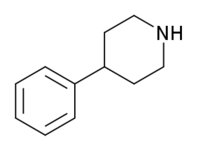4-Phenylpiperidine

| |
| Names | |
|---|---|
| IUPAC name
4-Phenylpiperidine
| |
| Identifiers | |
3D model (JSmol)
|
|
| ChEMBL | |
| ChemSpider | |
| ECHA InfoCard | 100.011.130 |
PubChem CID
|
|
CompTox Dashboard (EPA)
|
|
| |
| |
| Properties | |
| C11H15N | |
| Molar mass | 161.248 g·mol−1 |
Except where otherwise noted, data are given for materials in their standard state (at 25 °C [77 °F], 100 kPa).
| |
4-Phenylpiperidine is a chemical compound. It features a benzene ring bound to a piperidine ring.
4-Phenylpiperidine is the base structure for a variety of opioids, such as pethidine (meperidine), ketobemidone, alvimopan, loperamide, and diphenoxylate.
Preparation
- From the 3° alcohol, dehydration of which, and subsequent catalytic hydrogenation furnishes the product.
- 4-Phenylpyridine can also be catalytically hydrogenated.
Derivatives
Drugs derived from 4-phenylpiperidine proper include:
- 4-PPBP
- ADX-71149
- Ropitoin
- Altapizone
- Vesamicol
- JNJ-42153605
- #81 & #82, #160 & #162, #165, #166 & #167, #174 & #178 in U.S. patent 6,057,371
- Bromination of 4-PP gives para-bromo-4-PP [80980-89-8] U.S. patent 6,303,593. See also:[1]
4-phenylpiperdine core include:
A related compound is 4-benzylpiperidine, in which the rings are separated by a methylene bridge.
See also
References
- ^ Wenzel, Barbara; Sorger, Dietlind; Heinitz, Katrin; Scheunemann, Matthias; Schliebs, Reinhard; Steinbach, Joerg; Sabri, Osama European Journal of Medicinal Chemistry, 2005 , vol. 40, # 12 p. 1197 - 1205
